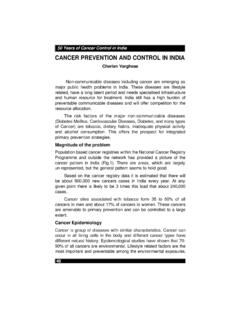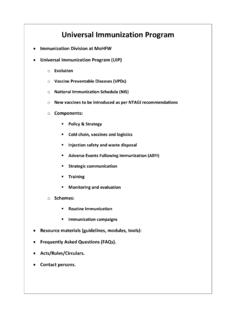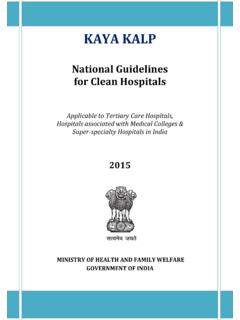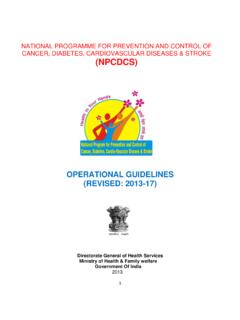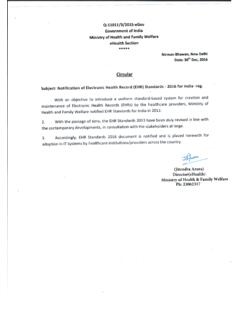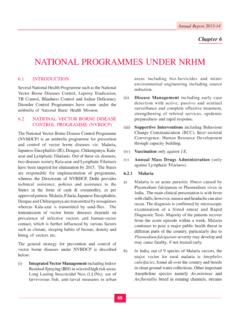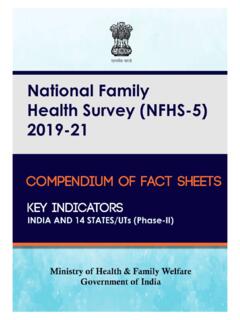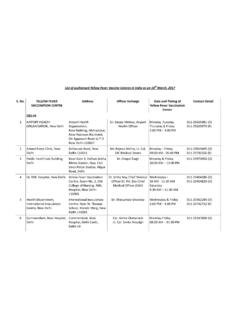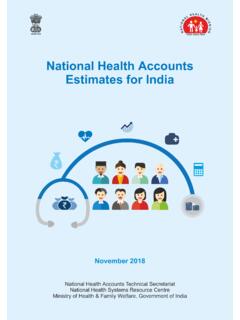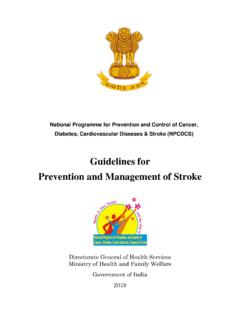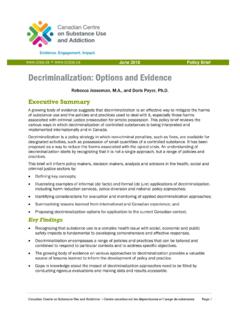Transcription of National Multisectoral Action Plan (NMAP) for Prevention and …
1 Table of ContentsAcronyms i1. Background 12. National Multisectoral Action Plan for Prevention and control of Common NCDs (2017-2022) 5 Integrated and Multisectoral coordination 6 Health Promotion Health Systems Strengthening Surveillance, Monitoring and Evaluation 83. Framework for Implementation 9 Timeframe for implementation Implementation Mechanism Role of Stakeholders Action Plan Matrix by Strategic Action Areas 114. Opportunities and Challenges 26 References 27 Annexures 291 Timeframe for Implementation 292 Details of implementation mechanisms 32 3 Role of key ministries 374 Role of select stakeholders 465 47 National Response to NCDs 6 49 National Programmes to address Noncommunicable DiseasesAYUSH Ayurveda, Yoga and Naturopathy, Unani.
2 Siddha and HomoeopathyCCHFW Central Council of Health and Family WelfareCHC Community Health CentreCHEB Central Health Education BureauCND Central NCD DivisionCOPD Chronic Obstructive Pulmonary DiseaseCOTPA Cigarettes and Other tobacco Products ActCoS Committee of SecretariesCSO Civil Society OrganizationCVDs Cardiovascular DiseasesDHR Department of Health Directorate General of Health ServicesDLCC District Level Coordination CommitteeFCTC Framework Convention on tobacco ControlFDI Foreign Direct Investment FSSAl Food Safety and Standards Authority of IndiaGATS Global Adult tobacco SurveyGDP Gross Domestic ProductGSHS Global School-based Health SurveyGST Goods and Services taxGYTS Global Youth tobacco SurveyHFSS High in Fat, Sugar and SaltHMIS Health Management Information SystemHP Health PromotionICMR Indian Council of Medical ResearchIEC Information.
3 Education and CommunicationIMC Inter-Ministerial CommitteeIRDA Insurance Regulatory and Development AuthorityIT Information TechnologyM&E Monitoring and EvaluationAcronymsiMGNREGA Mahatma Gandhi National Rural Employment Guarantee ActMoHFW Ministry of Health and Family WelfareMSG Mission Steering GroupNCDs Noncommunicable DiseasesNCF National Curriculum FrameworkNFHS National Family Health SurveyNGO Non-Governmental OrganizationNHM National Health MissionNHP National Health PolicyNIHFW National Institute of Health and Family WelfareNMP National Manufacturing PolicyNMAP National Multisectoral Action Plan for Prevention and control of common NCDsNMF National Monitoring FrameworkNMT Non-Motorized TransportNPCDCS National Programme for Prevention and control of Cancer, Diabetes, Cardiovascular Diseases and StrokeNTAG National Technical Advisory GroupNTCP National tobacco control ProgrammePCP Private Care ProvidersPHC Primary Health CentreSDG Sustainable Development GoalsSEZ Special Economic ZoneTAG Technical Advisory GroupToT Training of TrainersUN United NationsUNCT United Nations Country TeamUNSDF United Nations Sustainable Development FrameworkVHSNC Village Health Sanitation and Nutrition CommitteeWHA World Health AssemblyWHO World Health Organizationii1 India is experiencing rapid demographic and epidemiological transitions with NCDs causing significant disability, morbidity and mortality both in urban and rural populations and across all socioeconomic strata.
4 According to the ICMR State Level Disease Burden Initiative, in 2016, NCDs accounted to an estimated million deaths, constituting 62% of the total mortality of that four NCDs - Cardiovascular Diseases, Cancers, Diabetes and Chronic Respiratory Diseases - contributed to nearly 58% of the premature 1mortality in the age group 30-69 years. National Cancer Registry Programme has estimated cancer prevalence to be around four million, with over million new cases 2and estimated 733,000 deaths occurring in the country for the year 2016. ICMR INDIAB study has estimated prevalence of diabetes as and there are nearly 3,460 million people suffering from diabetes. Prevalence of Hypertension which is the principal risk for CVD, has considerably increased in Indian population in last two 5,6decades.
5 tobacco use is a leading risk factor for NCDs attributable to nearly million 7deaths every year. About of adults use tobacco products in some NCDs share modifiable behavioural risk factors such as tobacco use, unhealthy diet, lack of physical activity, and alcohol use. Air pollution has rapidly emerged as an important risk factor for NCDs. The behavioral and environmental risk factors lead to overweight and obesity, raised blood pressure and raised cholesterol, subsequently increasing the occurrence of CVDs, diabetes, cancers, and chronic respiratory diseases. A large proportion of NCDs are preventable. However, if no Action is taken, the cost of NCD burden over the next three decades is estimated to amount to trillions of 8dollars of lost resources.
6 In India, the share of NCDs in out-of-pocket health care 9expenditure is estimated to be more than 47%.The global pandemic of NCDs is a threat to Sustainable Development. The Sustainable Development Goals (SDGs) include reducing premature deaths from the four main NCDs by one-third by 2030. Furthermore, three of the nine health targets in SDGs also focus on NCDs-related are recognizable interconnections between health, particularly NCDs, and sustainable development. Effectively and sustainably addressing the health and developmental threat of NCDs requires careful attention to underlying social, cultural, economic, political, and environmental determinants that operate at societal level and in turn influence the behavioral risk factors. Vulnerable and socially disadvantaged populations face disproportionate risk and poor health outcome from actions to tackle these social determinants extend beyond the direct influence of the health sector and health policies.
7 Thus, public policies and decisions made in all sectors and at different levels of governance can have a significant impact on population health and 10,11health equity. 1. BackgroundFigure 1: Social Determinants of Health and NCDsNCDsRaised blood pressureOverweight/obesityRaised blood glucoseRaised lipidsTobacco useUnhealthy dietPhysical inactivityHarmful use of alcoholGlobalizationUrbanizationPopulati on ageingMetabolicphysiologicalrisk factorsBehaviouralrisk factorsUnderlying driversSocial Determinants of Health 2 Besides social determinants, the growing burden of NCDs is accelerated by the negative effects of globalization, rapid and unplanned urbanization and increasingly sedentary lives. It is recognized that effective NCDs Prevention and control require leadership, coordinated multi-stakeholder engagement and Multisectoral Action for health both at government level and at the level of a wide range of actors.
8 Health-in-all-policies and whole-of-government approaches require engagement across sectors such as health, agriculture, communication, education, employment, energy, environment, finance, food, foreign affairs, housing, justice and security, legislature, social welfare, sports, tax and revenue, trade and industry, transport, urban planning and youth affairs and 12,13partnership with relevant civil society and private sector health sector related interventions generally targeted at the upper level of the pyramid are costlier, while interventions at the lower portion of the pyramid cater to larger populations, are more cost-effective and Multisectoral in nature (figure1).Government of India's response to NCDs has been robust and aligned with Political Deceleration conveyed in the High-level Meeting on the Prevention and control of Non-communicable Diseases at the United Nations General Assembly (UNGA) in 2011 and 14,152014.
9 The National Programme for Prevention and control of Cancer, Diabetes, Cardiovascular Disease and Stroke (NPCDCS) has been expanded to cover entire country. Population Based Screening initiative for Hypertension, Diabetes and three common Cancers has been initiated for structured screening, disease management, 16referral and follow-up. The integration of services at district level and beyond has been brought under the umbrella of National Health Mission. Details of National NCD Programmes is mentioned at (Annex 6)3 tobacco control represents one of the most cost-effective interventions that are applied both at population and individual levels, with defined roles for multiple stakeholders beyond the health sector. The WHO FCTC is a legally binding global treaty ratified by India in 2004.
10 To drive the implementation of the WHO FCTC by different sectors, high level coordination committees have been established at National , state and district levels. The Ministries which have mostly contributed towards tobacco control at Union Government and State level include: Ministry of Human Resource Development, Ministry of Information and Broadcasting, Ministry of Home Affairs, Ministry of Labour, Ministry of Railways and Ministry of Finance. In addition Parliament, judiciary, civil society and media have also been significant allies for the advancement of tobacco control in India. Preliminary work is underway with the Ministry of Agriculture, Ministry of Labour, Department of Rural Development and Ministry of Environment and Forest for working out strategies to provide alternative livelihoods for those engaged in beedi rolling, tendu leaf plucking and tobacco cultivation.
